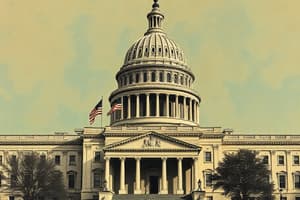Podcast
Questions and Answers
What is one of the major responsibilities of the legislative branch mentioned in the text?
What is one of the major responsibilities of the legislative branch mentioned in the text?
- Raising taxes without citizen approval
- Approving judicial appointments
- Drafting bills to create new agencies (correct)
- Commanding the armed forces
How does the legislative branch ensure transparency in decision-making processes?
How does the legislative branch ensure transparency in decision-making processes?
- By directly connecting with electorates (correct)
- By appointing Supreme Court justices
- By controlling state governors
- By issuing executive orders
What is the significance of the legislative branch overseeing the budget process?
What is the significance of the legislative branch overseeing the budget process?
- To allocate resources based on personal preferences
- To control the judiciary's budget
- To increase taxes for citizens
- To ensure wise spending of collected taxes (correct)
How does the legislative branch keep other arms of government in check?
How does the legislative branch keep other arms of government in check?
What is one direct impact of the legislative branch's activities on people's lives?
What is one direct impact of the legislative branch's activities on people's lives?
What is the primary role of the legislative branch in a democracy?
What is the primary role of the legislative branch in a democracy?
In the United States, what two bodies come together to form Congress?
In the United States, what two bodies come together to form Congress?
Which of the following best describes the concept of 'veto' in the context of the legislative branch?
Which of the following best describes the concept of 'veto' in the context of the legislative branch?
How can the legislative branch check and balance the executive branch?
How can the legislative branch check and balance the executive branch?
What are the three options available to the legislature when a bill is vetoed by the President?
What are the three options available to the legislature when a bill is vetoed by the President?
Flashcards are hidden until you start studying
Study Notes
Legislative Branch Overview
The legislative branch is one of the three branches of government in many democracies around the world. Its primary role is to make laws by debating proposed legislation and voting it into law. In most modern nations, these powers are given to a group called Parliament. However, there can also be other institutions such as state governments, which have similar functions within their specific jurisdiction. For example, in the United States, the House of Representatives and Senate together form Congress, which functionally acts like a parliament.
One of the key features of the legislative branch is its ability to check and balance the executive branch through various mechanisms. This includes being able to override certain decisions made by heads of states such as presidents or prime ministers. A notable example is the act of rejection known as 'veto'. If a president believes that a bill passed by both houses does more harm than good, they may choose to send back the bill with reasons stating why it cannot become law. Once this happens, the legislature has three options: pass the bill over the president's objections; amend it so much that it becomes unrecognizable from what was originally presented while still addressing the problem identified by the President; or let the bill die without any action taken by them.
In addition to checking the activities of the head of state, another important aspect of the legislative branch involves overseeing the budget process. This means making sure that enough money is appropriated for each department and agency within the federal system. While the end goal here might seem mundane—ensuring taxes are collected and spent wisely—it actually plays a vital role in keeping all citizens informed about how funds are allocated across different areas.
Lastly, among the major responsibilities of the legislative branch lies the drafting and passage of bills that create new agencies, change existing ones, set policies, and allocate resources. These activities directly impact people's lives, often determining whether they will receive social services or economic aid, among others. As a result, these parts of the job involve numerous interactions between elected representatives and their constituents. Indeed, it could be said that relations between members of congress and their voters play an integral part in shaping public policy.
Overall, the legislative branch serves as an essential component of democratic systems worldwide. It exercises crucial checks on other arms of government such as the judiciary and the executive, ensuring that none gains too much power. Moreover, its direct connection with electorates ensures transparency and accountability in decision-making processes.
Studying That Suits You
Use AI to generate personalized quizzes and flashcards to suit your learning preferences.




